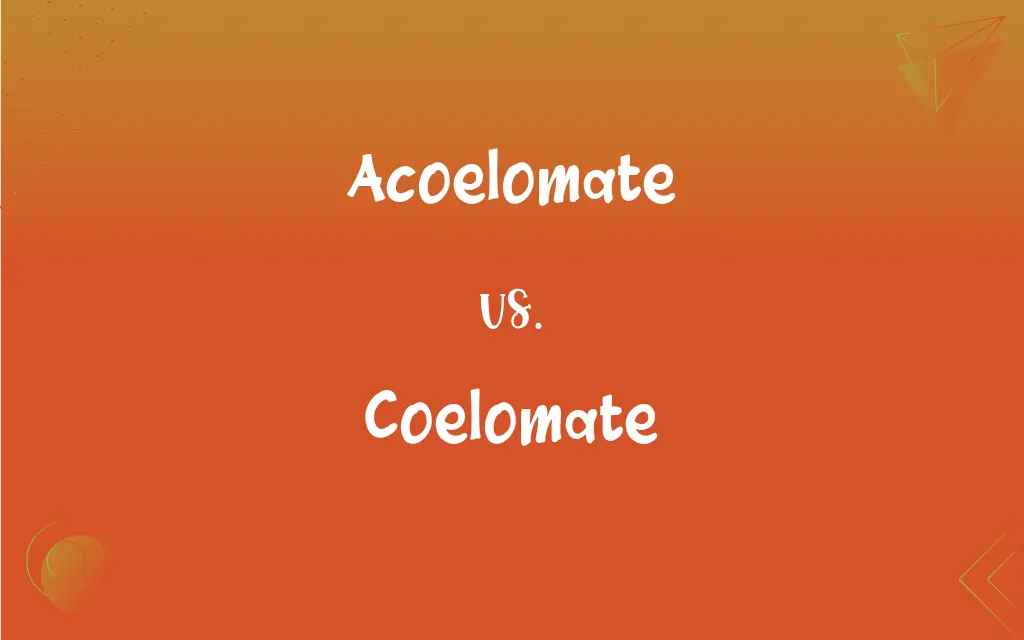Acoelomate vs. Coelomate: What's the Difference?
Edited by Aimie Carlson || By Harlon Moss || Updated on October 30, 2023
Acoelomates lack a body cavity (coelom), while coelomates have a true body cavity lined with mesoderm.

Key Differences
Acoelomates are organisms that lack a coelom, which is a fluid-filled body cavity completely surrounded by mesoderm tissue. In contrast, coelomates possess a coelom, providing a space for organs to develop and move independently. This difference is crucial in the classification and understanding of animal evolution and development.
Acoelomates, such as flatworms, have a solid body without a cavity between the digestive tract and outer body wall. Coelomates, like humans, have a true coelom, which not only provides space for organ development but also allows for greater complexity and specialization of organs.
In acoelomates, the space between the gut and body wall is filled with mesenchyme, a connective tissue, lacking a lined body cavity. In contrast, coelomates have a lined body cavity that provides a space where organs can develop, move, and interact in a more complex and specialized manner.
Acoelomates and coelomates represent two distinct groups of animals based on the presence or absence of a coelom. This distinction is fundamental in the study of animal anatomy, physiology, and evolution, providing insights into the complexity and diversity of animal life on Earth.
Comparison Chart
Body Cavity
Lacks coelom
Has a true coelom
ADVERTISEMENT
Example Organism
Flatworms
Humans
Level of Organ Complexity
Less complex
More complex
Space for Organs
No lined cavity
Lined cavity provides space
Impact on Evolution and Development
Less complexity limits evolution
Greater complexity aids evolution
Acoelomate and Coelomate Definitions
Acoelomate
An organism lacking a body cavity or coelom.
Flatworms are examples of acoelomates.
ADVERTISEMENT
Coelomate
A term used in classification of animals based on the presence of a coelom.
Coelomates are studied in contrast to acoelomates in biology.
Acoelomate
Refers to animals that have a solid body without a lined cavity for organs.
In acoelomates, the space between the gut and body wall is filled with mesenchyme.
Coelomate
Describes an evolutionary stage in animal development.
Coelomates represent a more advanced form of animal life.
Acoelomate
Describes an evolutionary stage in animal development.
Acoelomates represent a primitive form of animal life.
Coelomate
An organism with a true body cavity lined with mesoderm.
Humans are coelomates, possessing a coelom.
Acoelomate
A term used in classification of animals based on the absence of a coelom.
Acoelomates are studied in contrast to coelomates in biology.
Coelomate
A characteristic used to describe certain vertebrates and invertebrates.
Many vertebrates, such as mammals, are coelomates.
Acoelomate
A characteristic used to describe certain invertebrates.
Many invertebrates, such as flatworms, are acoelomates.
Coelomate
Refers to animals that have a body cavity with a lining that allows for organ development.
In coelomates, the coelom provides space for organs to develop and move independently.
Coelomate
Possessing a coelom
A coelomate animal.
Coelomate
(zoology) Any animal possessing a fluid-filled cavity within which the digestive system is suspended.
Coelomate
(zoology) Having a coelom.
FAQs
What is a coelomate?
A coelomate is an organism that has a true body cavity lined with mesoderm.
What are examples of coelomates?
Humans and other mammals are examples of coelomates.
How do acoelomates differ from pseudocoelomates?
Acoelomates lack a body cavity, while pseudocoelomates have a body cavity that is not completely lined with mesoderm.
What are examples of acoelomates?
Flatworms are examples of acoelomates.
How does the presence or absence of a coelom affect an organism's complexity?
The absence of a coelom in acoelomates limits their complexity, while the presence of a coelom in coelomates allows for greater complexity and specialization of organs.
Are humans acoelomates or coelomates?
Humans are coelomates, as they have a true body cavity lined with mesoderm.
How do acoelomates and coelomates differ in their level of organ complexity?
Acoelomates have less complex organs due to the absence of a coelom, while coelomates have more complex organs due to the presence of a coelom.
What is an acoelomate?
An acoelomate is an organism that lacks a body cavity or coelom.
How do acoelomates and coelomates differ in their evolutionary significance?
Acoelomates represent a more primitive form of animal life, while coelomates represent a more advanced form.
Do all animals have a coelom?
No, not all animals have a coelom. Some are acoelomates and lack a true body cavity.
Can acoelomates evolve into coelomates?
Evolutionarily, acoelomates represent a more primitive form of animal life, and some may have given rise to coelomates.
How does the absence of a coelom limit the evolution of acoelomates?
The absence of a coelom in acoelomates limits their complexity, which can affect their evolutionary potential.
How does the study of acoelomates and coelomates contribute to our understanding of animal evolution?
The study of acoelomates and coelomates helps us understand the complexity and diversity of animal life and provides insights into the evolutionary processes that led to the development of different body structures.
What is the function of a coelom?
The coelom provides space for organs to develop, move, and interact in a complex and specialized manner.
Are all invertebrates acoelomates?
No, not all invertebrates are acoelomates. Some invertebrates are coelomates.
What are the advantages of having a coelom?
Having a coelom allows for greater complexity and specialization of organs, which can be advantageous for an organism's survival and reproduction.
How does the presence of a coelom affect an organism's organ development?
The presence of a coelom allows for greater complexity and specialization of organs.
Are there any similarities between acoelomates and coelomates?
Both acoelomates and coelomates are categories used to classify animals based on their body cavity structure.
How are acoelomates and coelomates different?
Acoelomates lack a coelom, while coelomates have a true body cavity lined with mesoderm.
What is the significance of studying acoelomates and coelomates in biology?
Studying acoelomates and coelomates is significant in understanding animal evolution, anatomy, and physiology.
About Author
Written by
Harlon MossHarlon is a seasoned quality moderator and accomplished content writer for Difference Wiki. An alumnus of the prestigious University of California, he earned his degree in Computer Science. Leveraging his academic background, Harlon brings a meticulous and informed perspective to his work, ensuring content accuracy and excellence.
Edited by
Aimie CarlsonAimie Carlson, holding a master's degree in English literature, is a fervent English language enthusiast. She lends her writing talents to Difference Wiki, a prominent website that specializes in comparisons, offering readers insightful analyses that both captivate and inform.
































































